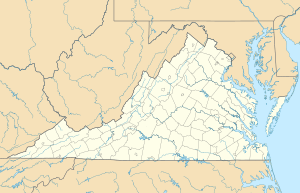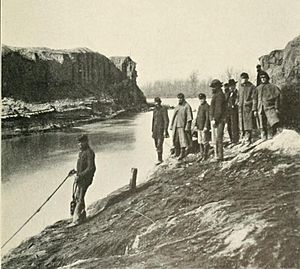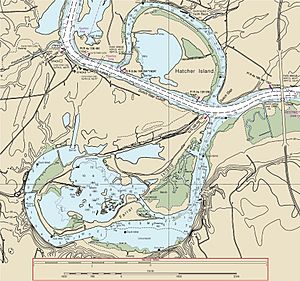Dutch Gap Canal facts for kids
Quick facts for kids 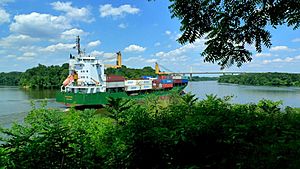
The container ship Reykjafoss on the Dutch Gap Canal heading downstream from Richmond towards Hampton Roads.
|
|
| Location | Chesterfield County, Virginia |
|---|---|
| Coordinates | 37°22′38″N 77°21′31″W / 37.377230°N 77.358698°W |
| Geology | canal |
The Dutch Gap Canal is a special waterway on the James River in Chesterfield County, Virginia. It's located near where the old 17th-century town of Henricus used to be. This canal was started during the American Civil War by Union soldiers. Their goal was to create a shortcut for ships. This shortcut would help them avoid a big bend in the river around a place called Farrar's Island. Confederate cannons controlled that bend.
After the war, the canal was finished. Today, it's the main path for the James River in this area. South of the canal, you can find the Dutch Gap Conservation Area and Henricus Historical Park.
Contents
Why is it Called Dutch Gap?
The Dutch Gap Canal gets its name from its location at "Dutch Gap." This was once a narrow strip of land that connected Farrar's Island to the mainland. The James River used to make many winding loops around Farrar's Island. The Dutch Gap was the narrowest point between two of these loops. Here, the river came very close to itself, making a long "Seven Mile Loop" around Farrar's Island. But the distance across the land at this point was less than 200 yards wide.
The name "Dutch Gap" has a long history. It's linked to the founding of Henricus in 1611 by Sir Thomas Dale. Some people called it "Dale's Dutch Gap." It's believed that Dale built a protective ditch with fences across this narrow strip of land. This was to defend the town from attacks. The name "Dutch Gap" might come from Sir Thomas Dale's time as a soldier for the Dutch Republic. He may have learned this building technique there.
Between 1619 and 1624, Dutch Gap was part of the City of Henrico. Later, in 1637, the land around the river loop became known as Farrar's Island. This was because William Farrar's son claimed it as his family's land.
Dutch Gap During the Civil War
During the American Civil War, in August 1864, General Benjamin Butler ordered the Dutch Gap Canal to be built. He was the commander of the Union Army in the area. One main reason for the canal was to let Union ships avoid the river bend around Farrar's Island. This area was heavily guarded by Confederate cannons. Powerful cannons and mortars were set up there, controlling a large area of the James River.
Another reason for building the canal was to keep the Confederate army busy. This was part of the larger Siege of Petersburg plan. It helped make sure the Confederates couldn't send their soldiers to fight in other places.
The canal was dug at the narrowest part of Dutch Gap. It was about 175 yards long when finished. Building it was very dangerous. Soldiers often worked while cannons from both sides fired at each other daily. Sometimes, Confederate cannons slowed down the work. They even sank a Union boat used to dig deeper into the canal.
By January 1865, the main digging was done. But when they tried to open the canal by blowing up a barrier, a lot of dirt fell back in. So, digging had to continue until the war ended. The canal was not fully ready for armed ships during the war.
African-American Soldiers at Dutch Gap
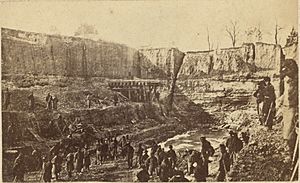
Most of the work on the Dutch Gap Canal was done by United States Colored Troops (USCT). Many of these soldiers were freedmen, meaning they had been freed from slavery. About 40% of the soldiers in General Butler's army were in USCT units. This was the highest percentage in any Union army during the Civil War. At least seven USCT groups helped with military tasks and digging at Dutch Gap.
Sometimes, the Union army treated USCT soldiers unfairly. They often gave them more hard labor tasks than white soldiers. This was a concern during the canal's construction. However, General Butler's army tried to treat all soldiers, including USCT units, more equally. At first, Butler asked both African-American and white soldiers to volunteer for the digging. They worked 7.5 hours a day and received extra pay and a daily drink.
But Butler soon realized the canal would take more time and resources. He stopped asking for volunteers and looked for more workers. This sometimes led to unfair treatment. USCT soldiers often had more digging duties than white soldiers. Also, some African-American workers from North Carolina were forced to work on the canal. They had been freed by Union forces but were then made to work against their will. They protested about not getting paid as promised. Because of their protest, they eventually received some pay. However, it was less than what soldiers doing similar work received.
The Dutch Gap Canal Dispute
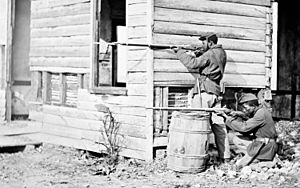
The Dutch Gap Canal also became important in talks about how captured black soldiers were treated. In 1863, the Confederate Congress said that captured black soldiers could be executed or enslaved. In response, President Lincoln's government ordered that for every black soldier executed, an equal number of Confederate soldiers would be put to death. And for every black soldier enslaved, a Confederate soldier would be forced into hard labor.
In October 1864, General Butler learned that captured black Union soldiers were being forced to build Confederate defenses. These defenses were under Union cannon fire. So, Butler ordered captured Confederate soldiers to work on the Dutch Gap Canal. This was happening even while Confederate cannons were firing at the canal.
A week later, Confederate General Robert E. Lee told Union General Ulysses S. Grant that captured African-American soldiers would be treated as regular prisoners of war. Lee also said that black soldiers were no longer working on Confederate defenses. In return, Grant ordered Butler to stop forcing Confederates to dig the canal.
After the Civil War
Even during the Civil War, people saw how important the canal could be for shipping goods to Richmond. Right after the war, the canal was still very basic. One traveler even called it a "One Horse Ditch." Still, its potential was clear when a steamer ship called the Clyde passed through it in May 1865.
For the next five years, the canal didn't develop much. The owner of Farrar's Island even filled in the northern end to create a road. But a flood in 1870 washed away this road. This allowed the canal to be further developed. It then became the main channel of the James River.
After 1871, the Army Corps of Engineers began making improvements. They deepened and widened the canal. This work continued through the 1870s. Making the canal and the rest of the James River ready for larger ships was a challenge. This may have slowed Richmond's growth as a port city after the Civil War.
In the 20th century, the canal continued to improve. By 1916, the James River channel, including the Dutch Gap Canal, was 22 feet deep. Since 1940, it has been 25 feet deep. Today, the canal is mostly used by container barges and smaller ships. They transport goods between Hampton Roads and Richmond.
Dutch Gap and Ancient Plants
Digging the Dutch Gap Canal uncovered an area with many fossils from the Cretaceous period. This makes it a great place to study paleobotany, which is the study of ancient plants. In 2013, scientists found the fossil of a new flowering plant called Potomacapnos apeleutheron. This plant lived about 120 million years ago. It might be one of the earliest eudicots (a type of flowering plant) found in North America.
The ancient flowering plant was named Potomacapnos apeleutheron to honor the freedmen who dug the canal. Potomacapnos refers to the area where the fossil was found. Apeleutheron is a Greek word meaning "freedmen."
Dutch Gap Area Today
Farrar's Island, which is just south of the Dutch Gap Canal, is now home to the Dutch Gap Conservation Area and Boat Landing and the Henricus Historical Park. A power plant owned by Dominion Energy is also nearby. It's on the south shore of the James River, close to an extension of the canal called the Dutch Gap Cutoff. This cutoff created another island called Hatcher Island.


